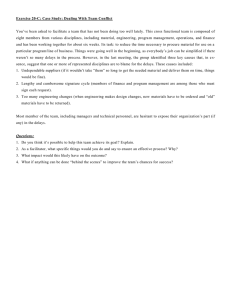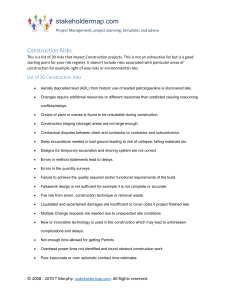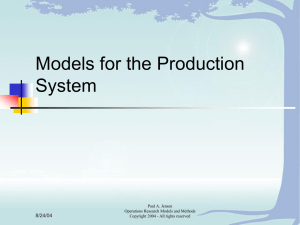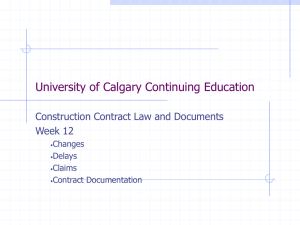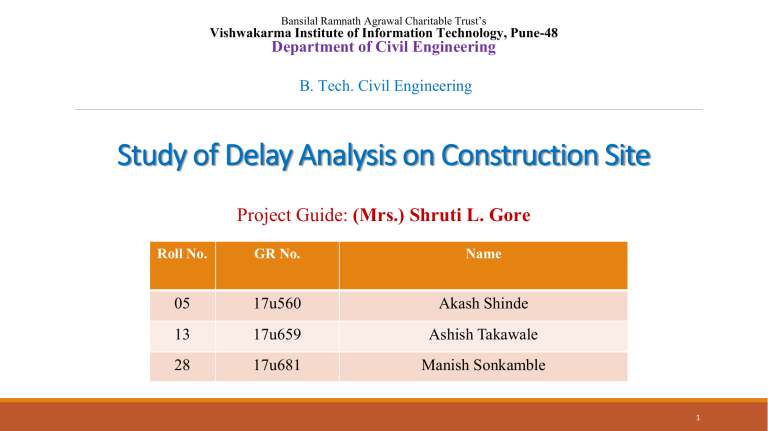
Bansilal Ramnath Agrawal Charitable Trust’s Vishwakarma Institute of Information Technology, Pune-48 Department of Civil Engineering B. Tech. Civil Engineering Study of Delay Analysis on Construction Site Project Guide: (Mrs.) Shruti L. Gore Roll No. GR No. Name 05 17u560 Akash Shinde 13 17u659 Ashish Takawale 28 17u681 Manish Sonkamble 1 Index 1. Abstract 9. Scoring & Analysis 2. Introduction 10. Conclusion & Recommendations 3. Aim & Objective 11. References 4. Problem Statement 5. Literature Review 6. Questionnaire Methodology 7. Data Collection 8. Use of Microsoft Power BI STUDY OF DELAY ANALYSIS ON CONSTRUCTION SITE 2 Abstract Time delay is one of the biggest problems in many construction buildings in India. The construction process is subject to many variables and unpredictable factors. Delay in project leads to loss of productivity, increased cost, contract termination and disputes between parties. The aim of this project is to examine the causes of delay on building construction project during construction phase. A study carried out on various delay analysis methods to evaluate the causes of delay and their impacts. A questionnaire survey is done to find the major causes of delay on construction sites. From the survey and study identified 24 causes of delay under some major groups. It is found that the most common factors of delay in most of the projects are “delay due to shortage of materials and equipment”. The outcome of the project is to analyse the occurrence of delays on construction sites due to various causes. STUDY OF DELAY ANALYSIS ON CONSTRUCTION SITE 3 Introduction Construction is the backbone of the development of any country. Delay in completion of construction projects usually result in the cost overruns and the delay in operation of any such kind of facility will lead to lost revenue to the owner. In construction delay is defined as, ‘the time overrun either beyond completion date specified in a contract or beyond the date that the parties agreed upon for delivery of a project.’ The delay in the project has an adverse effect on project success in terms of time, cost and quality. Delay of projects often leads to disputes and arbitration which again include extra cost and time. STUDY OF DELAY ANALYSIS ON CONSTRUCTION SITE 4 Aim and Objective Aim: This study aims to identify and analyse various of causes delays occurring on construction site across Pune. The objective of the project is: • To identify delay factors in construction projects. • To rank the delay factors according to the importance level on delays in project. • To use tools to analyse and evaluate the various delay factors in the construction building. STUDY OF DELAY ANALYSIS ON CONSTRUCTION SITE 5 Problem Statement Delay of projects often leads to disputes and arbitration which again include extra cost and time. For resolving claims related to extension of time and compensation it is very important to analyze the cause of delay and its impact on the project completion based on which extension of time and compensation related claims can be addressed well. It is needed to conduct detailed investigation and identification of delay factors and then selecting the right actions to counter theses delay factors within cost and maintaining quality. The faults and errors due to various factors cause delays and waste of capital. STUDY OF DELAY ANALYSIS ON CONSTRUCTION SITE 6 Literature Review Study on Delay Analysis • Construction project planning • Project scheduling • Progress monitoring Classification of Delays: • Critical Versus Non-Critical Delays • Excusable and Non-Excusable Delays • Compensable and Non-Compensable Delays STUDY OF DELAY ANALYSIS ON CONSTRUCTION SITE 7 Methodology • As-planned Impacted • As-planned versus As-built • Window Analysis • Time Impact Analysis STUDY OF DELAY ANALYSIS ON CONSTRUCTION SITE 8 Causes of Delay Group A - Contractor Group B - Owner Group C - Consultant Group D - Labour Group E - Materials & Equipment’s Group F - External Factors STUDY OF DELAY ANALYSIS ON CONSTRUCTION SITE 9 Questionnaire Methodology The survey is designed based to use Likert scale on the objective of the study to find out the causes of delays in construction projects and effect of the delays on overall project. The questionnaire basically consists of three sections as detailed below: • Respondent Background - This is to collect the basic information of the respondent. • Causes of Delays - This is used to collect the data on different causes of the delays happened in that particular project. • Measures for Minimizing Delays - The last part of the survey consists of questions regarding the methods they used to reduce the delays if any. STUDY OF DELAY ANALYSIS ON CONSTRUCTION SITE 10 Data Collection The practice of google form-based survey was implemented for collection of data across the industries. As seen in the below images we had two sections in the google forms. • Section I - The details of the company and the applicant • Section II - The questionnaire STUDY OF DELAY ANALYSIS ON CONSTRUCTION SITE 11 Data Collection in Excel: The data collected by survey method was stored in the excel sheets for further analysis as shown in the below image. Respondents consisted of some civil engineers, project managers and contractors. STUDY OF DELAY ANALYSIS ON CONSTRUCTION SITE 12 Use of Microsoft Power BI Microsoft Power BI Desktop is a free application that lets you connect to, transform, and visualize your data. With Power BI Desktop, you can connect to multiple different sources of data, and combine them (often called modelling) into a data model. The most common uses for Power BI Desktop are as follows: • Connect to data. • Transform and clean that data, to create a data model. • Create visuals, such as charts or graphs, that provide visual representations of the data. • Create reports that are collections of visuals, on one or more report pages • Share reports with others by using the Power BI service. STUDY OF DELAY ANALYSIS ON CONSTRUCTION SITE 13 Scoring and Analysis After the questionnaire is completed, each item may be analysed separately or in some cases item responses may be summed to create a score for a group of items. Hence, Likert scales are often called summative scales. Likert scales typically range from 2 to 10 with 5 or 7 being the most common. In the present survey a Likert scale of 1-3 was been used, where 1 indicates ‘Rarely’ and 3 indicates ‘Always’. Following table represents the top three contributors of delay in construction projects. Ranking Factor Points 1 Shortage of equipment 28 2 Late approval of design document/material 27 3 Shortage of material 27 STUDY OF DELAY ANALYSIS ON CONSTRUCTION SITE 14 Analysis STUDY OF DELAY ANALYSIS ON CONSTRUCTION SITE 15 The collected responses from different categories of people involved in construction project. The visualisations given below teaches us category wise delay occurred in construction industry. STUDY OF DELAY ANALYSIS ON CONSTRUCTION SITE 16 The following bar graph showing factors from Material & Equipment and Consultant categories. STUDY OF DELAY ANALYSIS ON CONSTRUCTION SITE 17 The following bar graph showing factors from Contractor and Owner categories. STUDY OF DELAY ANALYSIS ON CONSTRUCTION SITE 18 The following bar graph showing factors from Material & Equipment and Consultant categories. STUDY OF DELAY ANALYSIS ON CONSTRUCTION SITE 19 Conclusion Construction schedule delays in a project can cause major problems for contractors and owners, resulting in costly disputes, controversial issues and adverse relationships between all the project participants. The management of time is very critical in this industry because time equals to money thus estimating chances of schedule delay may play a significant role in the direction of project success. Basic knowledge of project schedule delay for the duration of whole project can save money and time. In the present study of survey it is found that the most common factors of delay which are repeated in most of the projects are delay due to “shortage of equipment and materials, late approval of documents, and lack of communication”. STUDY OF DELAY ANALYSIS ON CONSTRUCTION SITE 20 Recommendations • Project managers are recommended to get the approved list of materials from the contractor and then getting them delivered on the site in the proper time duration. • Contractors are recommended that proper care are taken in the project planning and scheduling stage. It is necessary to hire experienced contractors in the construction projects and do not allow frequent changing of subcontractors in between project tasks. • Owners are recommended that do not late in progress payments of contractors because it weakens the contractor ability to finance the work. Owners should not only have full knowledge about construction work but also have that level of experience so that they easily handle the project. • Designers should not make errors and late in producing design papers because it creates schedule delay in project. For this they need experienced design team for construction projects, and it is also important for the design engineers that they clearly understand the requirements of the owner before starting the work. STUDY OF DELAY ANALYSIS ON CONSTRUCTION SITE 21 Reference • International Journal of Engineering Research & Technology (IJERT) ISSN: 22780181 IJERTV4IS031166 www.ijert.org (This work is licensed under a Creative Commons Attribution 4.0 International License.) Vol. 4 Issue 03, March-2015 • AACE International Forensic Schedule Analysis, The Association for the Advancement of Cost Engineering, USA • Arya K. Analysing Delays of Construction Projects in India: Causes and Effects International, Journal of Science Technology & Engineering, 2016, 66-74. • Dinakar A. Delay Analysis in Construction Project, International Journal of Emerging Technology and Advanced Engineering. 2014; (4):784-788. • Iyer KC, Jha KN. Critical Factors Affecting Schedule Performance: Evidence from Indian Construction Projects. Journal of construction engineering and management, ASCE, 2006, 871-881. STUDY OF DELAY ANALYSIS ON CONSTRUCTION SITE 22 • Prakash Rao and Joseph Camron Culas (2014) “Causes of delays in Construction Projects – A case study”. International Journal of Current Research. • Pourrostam, T. and Ismail, A. (2012). Causes and Effects of Delay in Iranian Construction Projects. IACSIT International Journal of Engineering and Technology, 4(5): 201-203. • Larsen, J.K., Shen, G.Q. and Lindhard, S.M. (2015). Factors Affecting Schedule Delay, Cost Overrun, and Quality Level in Public Construction Projects. Journal of Management in Engineering, 32(1): 1-10. • Hale, D.R., Shrestha, P., Gibson, G.E. and Migliaccio, G.C. (2009). Empirical Comparison of Design/Build and Design/Bid/Build Project Delivery Methods. Journal of Construction Engineering and Management, 135(7): 579-587. STUDY OF DELAY ANALYSIS ON CONSTRUCTION SITE 23 Questions and Feedback STUDY OF DELAY ANALYSIS ON CONSTRUCTION SITE 24 This Photo by Unknown Author is licensed under CC BY THANK YOU! STUDY OF DELAY ANALYSIS ON CONSTRUCTION SITE 25
